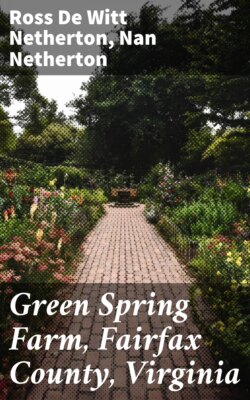Читать книгу Green Spring Farm, Fairfax County, Virginia - Ross De Witt Netherton - Страница 7
На сайте Литреса книга снята с продажи.
INTRODUCTION
ОглавлениеTable of Contents
The land has always had a special value to Virginians. Land was the first form of wealth which the colonists knew; and it was through cultivation of the land that Virginians first enjoyed the heady feeling of prosperity that came with the rise of their tobacco empire. Ownership and cultivation of the land were the goals of those who indentured themselves to come to the New World, and they were the foundations on which Jefferson placed his reliance for the perpetuation of political freedom and economic strength for the infant republic which emerged from the Revolution. For more than three centuries, Virginians have associated the land with values which are both physical and spiritual.
Against this background, the history of Green Spring Farm serves not only as a chronicle of the lives of three families who resided there but also as a reflection of the history of agriculture in Northern Virginia. Green Spring Farm was not one of the great estates of Tidewater Virginia. By the mid-eighteenth century, most of the original Northern Neck proprietary grants had been broken up and replaced by a pattern of smaller farms whose owners owed no allegiance to the tobacco empire and were willing to experiment with diversified crops. Green Spring Farm illustrated this emerging pattern of agriculture; and its first owners, John Moss and his heirs, who assembled the acreage in the 1770’s and occupied it until 1839, were typical of the freeholder classes who took pride in their land and in regarding themselves as farmers. Their farming raised Virginia to its position of preeminance among the colonies and in the new nation after the Revolution.
Farming remained the foundation of Virginia’s economy through the nineteenth century, although changes in the methods of husbandry and transportation, together with the opening of farmlands in the Ohio Valley and the prairie states, had important consequences in Virginia. These impacts were followed by the devastating years of war from 1861 to 1865. Agriculture in Northern Virginia reached its low point in the 1870’s.
The period of rebuilding in Northern Virginia—the “Energetic Eighties,” as one historian has called these years—brought a revival of agriculture. Farmers who could no longer compete in one agriculture market shifted to another where they enjoyed natural advantages. Thus, Green Spring Farm, under the ownership of Fountain Beattie from 1878 to 1917, became chiefly an orchard and dairy farm.
Under the ownership of Michael Straight, from 1942 to the present (1969), Green Spring Farm came under assault from new economic forces which drastically affected farming in Northern Virginia and ultimately brought an end to the agricultural era there. Unlike the changing times of earlier centuries, there was no compromise with the forces of expanding urbanization; and, eventually, even stock farming was ended. Yet, in the twentieth 2 century, as in the eighteenth and nineteenth, the farm continued to represent values which were social as well as economic. The alert eye of a Russian writer catches some of this value in “A Visit from Mr. Polevoy,” reproduced in the appendix, just as the inventories of the estates of earlier owners of the farm suggest the social values which were held in their times.
Green Spring Farm therefore offers insight into the lives of Virginia gentlemen of the eighteenth, nineteenth, and twentieth centuries. Its owners were men of learning according to their times, and men of affairs. The history of the farm records many references to occasions when it was a gathering place for colorful and talented people whose names were notable in the arts, literature, sciences, and politics of their day. Throughout the eighteenth, nineteenth, and twentieth centuries, its owners were sought for public service and held positions of trust and responsibility in county, state, and national governments.
The architectural history of Green Spring Farm parallels its chain of title. Both the structure and interior design of its buildings have undergone numerous alterations and remodelings. None of these changes, however, has destroyed the simple dignity of the house, and it stands today as a symbol of the traditional strength of spirit of the Virginia freeholder-farmer in an area which is undergoing the transition of America’s urban revolution.
3
